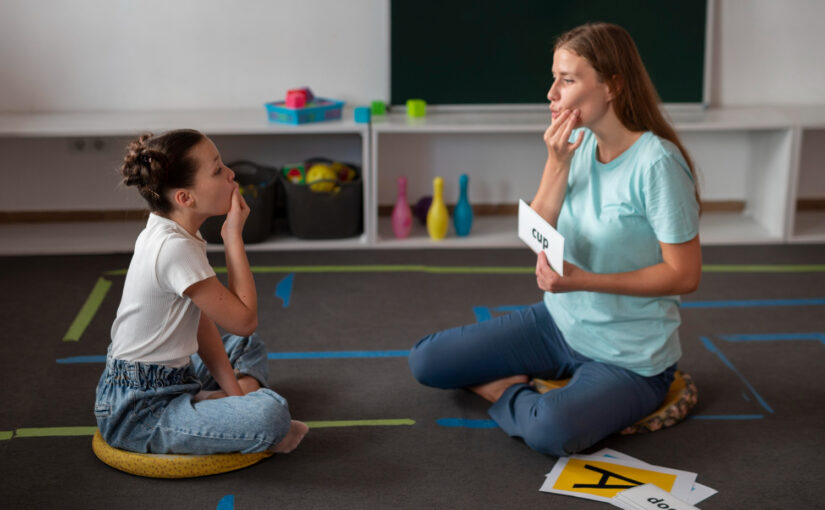To achieve success in education and social life, a strong foundation in English literacy is a crucial requirement for every child.
Phonics helps children bridge the gap between what they see (read) in writing on paper and how they pronounce (say) the word when they are speaking.
Phonics builds stronger communication skills by improving proper pronunciation and spelling capabilities.
Phonics is essential for your children because normal look-and-say (reading) training programs limit the scope of their communicational capabilities.
Synthetic Phonics training in Mumbai is based on the synthetic phonics method of teaching; it is a multi-sensory, child-centered, and fun-based teaching method.
If your child is between the ages of 3 to 5 years, that’s an ideal age for enrolling in Synthetic Phonics courses in Mumbai.
What if you belong to a higher age group?
No problem!
The Synthetic Phonics course in Mumbai is beneficial to older children, even adults, who are looking forward to developing good English speaking, writing, and reading skills for educational purposes or as an employment-related requirement.
At the end of the Synthetic Phonics course in Mumbai, children can read, spell, and speak with confidence.
The five core skills of Synthetic Phonics
Lesson based on letter sound [Learning the letter sound]
In Synthetic Phonics, the first skill that needs to be taught to the children is letter sounds. The 42 sounds in English are divided into 7 groups of sounds, where each group consists of 6 sounds, such as /s/, /a/, /t/, /i/, /p/, /n/, and so forth.
Each sound is allocated a storyline and an associated action, which helps children to remember sounds properly. Flashcards (as a visual aid) and sound books (for reading) are provided to the children in order to practice and hone the necessary skills. Children are taught to recognize digraphs.
Lesson based on letter-formation [Learning letter formation]
In order to make children imitate letter formation correctly, the teacher shows letter formation patterns in the air, through the flashcard, and on the board. Another activity includes matching pictures representing letter sounds with letter formation.
Lesson based on blending [Blending for reading]
As per the Synthetic Phonics methodology, blending lessons must start only after the teacher teaches the first six letter sounds with the help of flashcards. Children must be able to understand sounds, to mix them in order to form words. To learn to create words, children must learn to recognize and listen to someone speaking it. Such skills are required to make notes of unfamiliar words. On the other hand, the ability to blend the sound enhances reading fluency. Home reading programs help children practice their reading and blending skills.
Lesson based on identifying sounds [Identifying sounds in words for writing]
In this lesson, children are expected to listen for the spoken word, and identify, and write the sound they heard in the form of words. This will give them a better understanding of the writing and reading process.
In the modeling and copying technique, children are asked to try to write on the board after the teacher slowly rubs the word written on the board. In the children’s free-writing technique, children are allowed to write independently on any topic from friends to toys, but the alphabet and the tricky words are provided by the teacher beforehand. By this method, children are getting used to writing and getting ready to be independent writers.
Lesson based on tricky words [Tricky words]
Tricky words frequently appear in normal text but are difficult to spell. Tricky words cannot be merged. For example, the word ‘live’ where the /e/ sound is the tricky part. While pronouncing, the word ‘was’ has an /o/ sound instead of an /a/ sound, also a tricky word.
Children are introduced to tricky words through flashcards, snapping games, and outdoor activities. To boost children’s learning motivation, outdoor activities like the look, copy, cover, write, and check – the game is played.
With the help of all five Synthetic Phonics skills, children will be able to develop and enhance their English literacy skills, where children learn most sounds of the letter, remember the most tricky forms of words, they also attain the capability to blend, read and at the same time write independently.
Synthetic Phonics course training in Mumbai is an effective teaching methodology for enhancing children’s English language communicational literacy. Synthetic Phonics course motivates teachers, who work hard to see students achieve.
National Academy’s Synthetic Phonics training (course in Mumbai) curriculum covers 42 letter sounds, letter formation, blending, segmenting, tricky words, alternative spellings of vowel sounds, spelling rules, and teaching sequence, which also includes various enjoyable techniques involving children’s sight, sound, and kinesthetic means.




